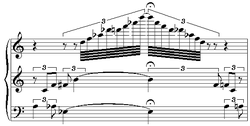created 2025-05-12, & modified, =this.modified
rel: Oulipo
Thought
Is a palindrome a Holes or and Islands or a bridge? Or a shadow?
They do seem to have aspects of a shadow, but it’s not an identical shadow. If it were a shadow, it’d be a hole, but it doesn’t seem like a hole. Maybe a bridge, but a fixed bridge between words?
Palindromes are very interesting. There’s internal structure that affects how choice works.
How to compose a palindromic poem? Since a palindrome has mirrored halves, there’s a tension between intentional choice, and acceptance in its writing. It is as if half of the poem is written, which simultaneously forces language decisions, so the other half (that is mirrored) is more of an accepted consequence of the former.
This tension exists elsewhere in writing, but the overt structural rules make it really apparent in palindrome.
Many poets will do this to adhere to form, selecting from a set of rhyming words rather than “conjuring” one. Maybe this is similar to use of a reference in drawing, which by some outside of the art world would see as “cheating” but is a valid and often used technique. What is created need not always be conjured completely from within, produced only by the artist, if such a thing is even possible.
Numbers
Palindromic numbers exist. I do not find them as fascinating as words (but maybe a mapping exists.)
Here are some:
0, 1, 2, 3, 4, 5, 6, 7, 8, 9, 11, 22, 33, 44, 55, 66, 77, 88, 99, 101, 111, 121, 131, 141, 151, 161, 171, 181, 191, 202
In 2018, a paper was published demonstrating that every positive integer can be written as the sum of three palindromic numbers in every number system with base 5 or greater
Music

I’m reading a segment in Art-Science - Alloys by Iannis Xenakis and this comes to mind. They are discussing time, and the reversal of time.
Serres: Yes, when you come along with compositions based on stochastics, that touches upon the problem of time. When composing, what relations do you draw between order and disorder? I know what disorder is because I know how you handle that. But what is order, what is your syntax?
Xenakis: Well, there are several facets. For example, I can say there’s order when there’s symmetry.
Serres says he has won, “so that means we’re going to come back to the question of time. If there is symmetry there can be reversability …”
Xenakis: “No, because there can be order in non-temporal things. That’s why it’s absolutely indispensable to distinguish between what is in and what is outside of time. For example, I’ll take a group of keys on a piano (an elementary case). I then have intervals which repeat themselves, but they are never repeated in time; they’re there, fixed. The piano keys are on a piano which doesn’t move.”
He says the keys, and syntax are outside of time.
Thought
This dialogue makes me wonder what the center of a palindromic sentence is, as it is being constructed? What does the line between the positive and negative trace?